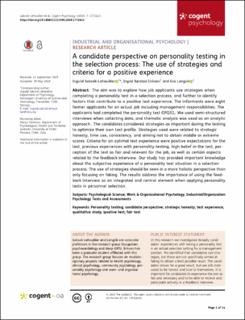| dc.contributor.author | Saksvik-Lehouillier, Ingvild | |
| dc.contributor.author | Eriksen, Ingrid Børstad | |
| dc.contributor.author | Langvik, Eva Oddrun | |
| dc.date.accessioned | 2020-10-28T06:59:14Z | |
| dc.date.available | 2020-10-28T06:59:14Z | |
| dc.date.created | 2020-07-02T15:27:56Z | |
| dc.date.issued | 2020 | |
| dc.identifier.citation | Cogent Psychology. 2020, 7 (1), . | en_US |
| dc.identifier.issn | 2331-1908 | |
| dc.identifier.uri | https://hdl.handle.net/11250/2685380 | |
| dc.description.abstract | The aim was to explore how job applicants use strategies when completing a personality test in a selection process, and further to identify factors that contribute to a positive test experience. The informants were eight former applicants for an actual job including management responsibilities. The applicants had completed the personality test OPQ32i. We used semi-structured interviews when collecting data, and thematic analysis was used as an analytic approach.. The candidates considered strategies as important during the testing to optimize their own test profile. Strategies used were related to strategic honesty, time use, consistency, and aiming not to obtain middle or extreme scores. Criteria for an optimal test experience were positive expectations for the test, previous experiences with personality testing, high belief in the test, perception of the test as fair and relevant for the job, as well as certain aspects related to the feedback interview. Our study has provided important knowledge about the subjective experience of a personality test situation in a selection process. The use of strategies should be seen in a more holistic perspective than only focusing on faking. The results address the importance of using the feedback interview as an integrated and central element when applying personality tests in personnel selection. | en_US |
| dc.language.iso | eng | en_US |
| dc.publisher | Cogent oa | en_US |
| dc.rights | Navngivelse 4.0 Internasjonal | * |
| dc.rights.uri | http://creativecommons.org/licenses/by/4.0/deed.no | * |
| dc.title | A candidate perspective on personality testing in the selection process: The use of strategies and criteria for a positive experience | en_US |
| dc.type | Peer reviewed | en_US |
| dc.type | Journal article | en_US |
| dc.description.version | publishedVersion | en_US |
| dc.source.pagenumber | 0 | en_US |
| dc.source.volume | 7 | en_US |
| dc.source.journal | Cogent Psychology | en_US |
| dc.source.issue | 1 | en_US |
| dc.identifier.doi | 10.1080/23311908.2020.1772631 | |
| dc.identifier.cristin | 1818332 | |
| dc.description.localcode | © 2020 The Author(s). This open access article is distributed under a Creative Commons Attribution (CC-BY) 4.0 license. You are free to: Share — copy and redistribute the material in any medium or format. Adapt — remix, transform, and build upon the material for any purpose, even commercially. The licensor cannot revoke these freedoms as long as you follow the license terms. Under the following terms: Attribution — You must give appropriate credit, provide a link to the license, and indicate if changes were made. You may do so in any reasonable manner, but not in any way that suggests the licensor endorses you or your use. No additional restrictions You may not apply legal terms or technological measures that legally restrict others from doing anything the license permits. | en_US |
| cristin.ispublished | true | |
| cristin.fulltext | original | |
| cristin.qualitycode | 1 | |

